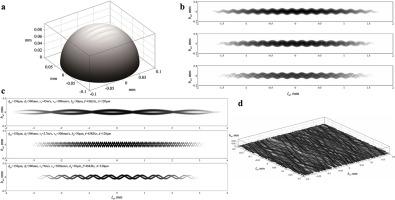International Journal of Machine Tools and Manufacture ( IF 14.0 ) Pub Date : 2020-07-09 , DOI: 10.1016/j.ijmachtools.2020.103595 Jingliang Jiang , Shufeng Sun , Dexiang Wang , Yong Yang , Xinfu Liu

|
It is widely accepted that surface textures can significantly improve the tribological properties of surfaces. The purpose of this research was to study surface texture formation mechanism through the ultrasonic vibration-assisted grinding process. First, a single grain cutting process model was established, and the cutting trajectory length and shape were calculated. Second, the single grain profile models were established that considered the dressing effect. Then, by considering continuous cutting process of large amounts of grains, the surface texture formation mechanism model was established. The calculation results were verified by experiments. Finally, the characteristic parameters that described the surface texture topography were proposed and the influence law of the process parameters was analyzed. The results of this research showed that the established theoretical model could accurately describe the ultrasonic vibration-assisted grinding process and the topographical characteristics of the surface texture. By controlling the process parameters, surface textures with controllable topography could be processed. This work can provide a substantially theoretical basis for processing surface textures efficiently.
中文翻译:

基于超声振动磨削的表面纹理形成机理
人们普遍认为表面纹理可以显着改善表面的摩擦学性能。这项研究的目的是研究通过超声振动辅助磨削过程的表面纹理形成机理。首先,建立了单一的谷物切割过程模型,并计算了切割轨迹的长度和形状。其次,建立了考虑修整效果的单一晶粒轮廓模型。然后,考虑到大量晶粒的连续切削过程,建立了表面纹理形成机理模型。通过实验验证了计算结果。最后,提出了描述表面纹理形貌的特征参数,并分析了工艺参数的影响规律。研究结果表明,所建立的理论模型可以准确地描述超声振动辅助的磨削过程和表面纹理的形貌特征。通过控制工艺参数,可以处理具有可控形貌的表面纹理。这项工作可以为有效地处理表面纹理提供基本的理论基础。











































 京公网安备 11010802027423号
京公网安备 11010802027423号